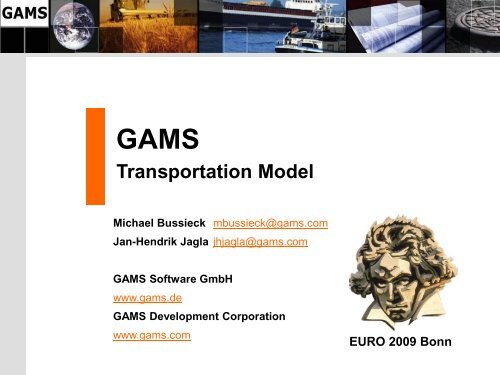Transportation Model - Gams
Transportation Model - Gams
Transportation Model - Gams
You also want an ePaper? Increase the reach of your titles
YUMPU automatically turns print PDFs into web optimized ePapers that Google loves.
GAMS<br />
<strong>Transportation</strong> <strong>Model</strong><br />
Michael Bussieck mbussieck@gams.com<br />
Jan-Hendrik Jagla jhjagla@gams.com<br />
GAMS Software GmbH<br />
www.gams.de<br />
GAMS Development Corporation<br />
www.gams.com<br />
EURO 2009 Bonn
2<br />
What is a <strong>Model</strong>?<br />
• Mathematical Programming (MP) <strong>Model</strong><br />
– List of Equations<br />
• Collection of several intertwined MP <strong>Model</strong>s<br />
– Data Preparation<br />
– Data Calibration<br />
– “Solution” Module (e.g. sequential, parallel, loop)<br />
– Report Module
3<br />
A <strong>Transportation</strong> <strong>Model</strong><br />
San Diego<br />
Seattle<br />
600<br />
350<br />
1.8<br />
2.5<br />
1.7<br />
1.8<br />
2.5<br />
1.4<br />
Minimize <strong>Transportation</strong> cost<br />
subject to Demand satisfaction at markets<br />
Supply constraints<br />
325<br />
275<br />
300<br />
New York<br />
Topeka<br />
Chicago
4<br />
Mathematical Algebra
5<br />
GAMS Algebra
6<br />
A few Word about GAMS Syntax<br />
• Symbols:<br />
– Sets<br />
– Parameters<br />
– Variables<br />
– Equations<br />
– <strong>Model</strong>s<br />
– ASCII Output Files<br />
• Statements<br />
– Declarations<br />
– Data Assignments<br />
– Equation Definition<br />
– Programming Flow Control<br />
– Option statement
7<br />
Hands-on! <strong>Transportation</strong> <strong>Model</strong>
8<br />
Modifications to the transport model<br />
LP<br />
MIP<br />
NLP<br />
MINLP<br />
Put<br />
Utilities<br />
GDX<br />
Utilities<br />
Convert +<br />
Dumpopt
9<br />
Types of Variables<br />
• Continuous Variables<br />
– Free/Positive/Negative<br />
– Lower and/or upper bound<br />
• Binary Variables<br />
– Either 0 or 1<br />
• Integer Variables<br />
– by default ranging between 0 and 100<br />
• Semicont/Semiint Variables<br />
– 0 or above a given minimum<br />
• Special Ordered Set Variables (SOS1, SOS2)
10<br />
Binary Variables<br />
• Powerful Tool to model yes/no decisions<br />
• <strong>Model</strong>s with discrete variables (MIP)<br />
– Solved using Branch-and-Cut algorithms (lots or LPs)<br />
– Theoretically difficult problem class<br />
– Practical:<br />
• mixed bag<br />
• Art of <strong>Model</strong>ing<br />
• Example: Minimum Shipment<br />
– Ship at least 100 tons or don’t ship
11<br />
Minimum Shipment<br />
• Continuous Variable x (shipment)<br />
• Binary Variable ship (indicator for minimum shipment):<br />
– ship=1 if x > 100<br />
– ship=0 if x = 0<br />
• Coupling Constraints:<br />
– x > 100 * ship<br />
– x < bigM * ship<br />
• How big do we have to make bigM?
12<br />
Implement Min/Max Shipments (MIP)<br />
Parameter rep1(i,j,*) Shipments between plants and markets<br />
rep2(*) Objective value;<br />
rep1(i,j,'lp') = x.l(i,j);<br />
rep2('lp') = z.l;<br />
scalars xmin / 100 /<br />
xmax / 325 /;<br />
binary variables ship(i,j) decision variable to ship<br />
equations minship(i,j) minimum shipments<br />
maxship(i,j) maximum shipments ;<br />
minship(i,j).. x(i,j) =g= xmin*ship(i,j);<br />
maxship(i,j).. x(i,j) =l= xmax*ship(i,j);<br />
model m2 min shipments / all /;<br />
solve m2 using mip minimizing z;<br />
rep1(i,j,'mip') = x.l(i,j);<br />
rep2('mip') = z.l;<br />
option mip=coincbc<br />
solve m2 using mip minimizing z;<br />
rep1(i,j,'mip-coincbc') = x.l(i,j);<br />
rep2('mip-coincbc') = z.l;<br />
display rep1,rep2;
13<br />
Economy of Scales: Cost = Volume factor<br />
Cost<br />
30<br />
25<br />
20<br />
15<br />
10<br />
5<br />
0<br />
1 2 3 4 5 6 7 8 9 10 11 12 13 14 15 16<br />
Volume<br />
factor>1<br />
Series1<br />
factor=1<br />
Series2<br />
Series3<br />
factor
14<br />
Implement Nonlinear Cost (NLP)<br />
* nonlinear cost<br />
equation nlcost nonlinear cost function;<br />
scalar beta;<br />
nlcost.. z =e= sum((i,j), c(i,j)*x(i,j)**beta);<br />
model m3 / nlcost,supply,demand /;<br />
beta = 1.5;<br />
solve m3 using nlp minimizing z;<br />
rep1(i,j,'nlp-convex') = x.l(i,j);<br />
rep2('nlp-convex') = z.l;<br />
beta = 0.6;<br />
solve m3 using nlp minimizing z;<br />
rep1(i,j,'nlp-concave') = x.l(i,j);<br />
rep2('nlp-concave') = z.l;<br />
option nlp=baron;<br />
solve m3 using nlp minimizing z;<br />
rep1(i,j,'nlp-baron') = x.l(i,j);<br />
rep2('nlp-baron') = z.l;<br />
display rep1,rep2;
15<br />
Implement Min/Max and Nonlinear (MINLP)<br />
* min/max and nonlinear objective<br />
model m4 / nlcost,supply,demand,minship,maxship /;<br />
option minlp=baron;<br />
solve m4 using minlp minimizing z;<br />
rep1(i,j,'minlp-bar') = x.l(i,j);<br />
rep2('minlp-bar') = z.l;<br />
option minlp=lindoglobal;<br />
solve m4 using minlp minimizing z;<br />
rep1(i,j,'minlp-lin') = x.l(i,j);<br />
rep2('minlp-lin') = z.l;<br />
display rep1,rep2;
16<br />
Data Connectivity<br />
• Data Import/Export from Standard Applications<br />
Text files<br />
<strong>Gams</strong> Data eXchange (GDX)<br />
• MS Office, Databases, …<br />
• Capture an Instance<br />
– Reproducibility of <strong>Model</strong>/System Bugs<br />
– Problems: Life Database/different Platforms<br />
convert<br />
dumpopt
17<br />
Put Utility<br />
set help(*)<br />
option help
18<br />
GDX and GDXXRW<br />
• execute_unload 'all.gdx';<br />
• gdx=all2<br />
gdxdiff<br />
• execute_unload 'reports.gdx' rep1, rep2;<br />
execute 'gdxxrw reports.gdx par=rep2 cdim=1 rdim=0 rng=Report!c1';<br />
execute 'gdxxrw reports.gdx par=rep1 cdim=1 rdim=2 rng=Report!a4';
19<br />
Capture an Instance with convert /dumpopt<br />
• GAMS “solver”: convert<br />
– gams mymodel modeltype=convert<br />
or<br />
– option minlp=convert;<br />
solve m4 using minlp minimizing z;<br />
anonymized scalar model gams.gms and dictionary<br />
dict.txt<br />
• GAMS option: dumpopt<br />
– gams mymodel dumpopt=11<br />
mymodel.dmp with all source and data
















